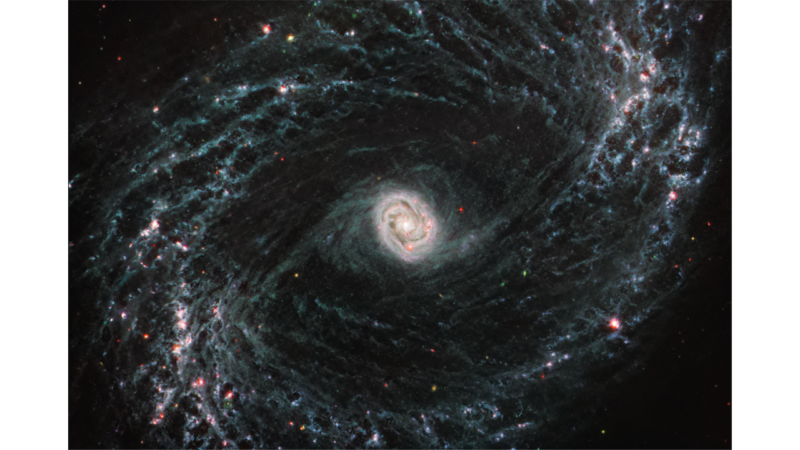
Galaxies pass through gas – in the case of galaxy NGC 4383, so much so that the gas outflow is 20,000 light-years across and has a mass of more than 50 million suns.
Yet even an outflow from this immensity has been difficult to detect until now. Observing what these outflows consist of and how they are structured requires high-resolution instruments that can only see gas from galaxies that are relatively nearby, so information about them is limited. That’s a shame, because the outflow of gas from galaxies can tell us more about their star formation cycles.
The MAUVE program (MUSE and ALMA Unveiling the Virgo Environment) is now changing that. MAUVE’s mission is to understand how the outflow of galaxies in the Virgo cluster affects star formation. NGC 4383 caught the eye of astronomer Adam Watts of the University of Australia and the International Center for Radio Astronomy Research (ICRAR) and his team because the outflow is so enormous.
The elements it releases into space could reveal the galaxy’s potential to form (or stop forming) stars. “Understanding the physics of feedback-driven stellar outflows is essential to complete our picture of galaxy evolution,” the researchers said in a study recently published in Monthly Notices of the Royal Astronomical Society.
Star potential
Stellar feedback, consisting of all the radiation, particle winds, and other materials that stars blow into the interstellar medium, creates an outflow as large as that in NGC 4383. Much of this material comes from bursts of star formation or from the interiors of galaxies . massive stars when they die and become a supernova. It includes heavier elements that escape into space with the outflow and float there indefinitely, sometimes ending up in other galaxies.
Star formation in a galaxy depends on several processes. There must be the right balance of gas accretion (growth from added gas), consumption (the burning of hydrogen and helium by stars), and expulsion (when interstellar gas is blown out of the galaxy) between the intergalactic medium and the circumgalactic medium. the gas that surrounds galaxies. Some of the gas and other materials, such as iron and other heavy elements, that make up stars can be recycled through supernova explosions.
The supply of gas is crucial because large amounts of gas eventually collapse due to their enormous gravity and eventually form stars. A shortage of gas can suppress the formation of potential stars.
Watts and his team think that one source of the stellar feedback pushing star-forming gas from NGC 4383 is multiple supernovae that occurred relatively close together. Supernovae can form giant bubbles of scorching gas that eventually break vertically from a galactic disk and extend from the top and bottom of the galaxy.
Hot gas penetrates into cooler regions of the interstellar medium, with gravity pulling in more gas on its way out of the galaxy and increasing the total mass of the outflow (also called a mass load). The loss of that much gas further reduces the chance of star formation.
Lost in space
Outflows can be observed at many different wavelengths. X-ray emissions from elements such as hydrogen and compounds such as carbon monoxide can be detected. It is also possible to observe outflows using UV, optical and infrared. Some of the emissions in the region had already been observed with other telescopes, which were combined with MAUVE images of the Virgo Cluster and NGC 4383 at different wavelengths.
The problem with accurately observing the outflow is that the dispersed materials are notoriously spatially resolved, meaning the distance of the entire outflow must be calculated from pixels. MAUVE, NGC 4383 and the Virgo Cluster were observed at a spatial resolution of about 261 light-years, so that each pixel represented a square in space measuring 261 light-years on each side. Clumps of ionized gas appearing in these pixels told the research team that there was a bipolar outflow leaving the galaxy from above and below.
So does NGC 4383 have reduced star formation due to the massive outflow of stellar material? It turns out that stars actually form at the edge of the galaxy. Although stars are not forming in the stream escaping the galaxy, there are still areas where enough gas has built up for them to form.
These starbursts, or regions of rapid star formation, also provide stellar feedback – they’re not just supernovae. “There is an expansion of blue knots that are much brighter in the near UV region and are clear evidence of star formation beyond the main Milky Way,” the researchers said in the same study.
Something that remains unclear about NGC 4383 is whether the gas outflow was caused solely by stellar feedback or whether a gravitational interaction with another galaxy intensified the existing outflow. There may be evidence for this on the eastern side, where a disturbance in the gas suggests a nearby dwarf galaxy may have interacted with it. For now, the research team is confident that the outflow is mainly caused by starbursts and supernovae.
There’s more the researchers want to know about NGC 4383 and its outflow. As telescopes become more sophisticated and spatial resolution improves, perhaps something else will be revealed in those gas clouds.